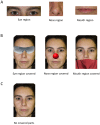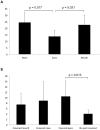Part-based and configural processing of owner's face in dogs
- PMID: 25251285
- PMCID: PMC4177116
- DOI: 10.1371/journal.pone.0108176
Part-based and configural processing of owner's face in dogs
Abstract
Dogs exhibit characteristic looking patterns when looking at human faces but little is known about what the underlying cognitive mechanisms are and how much these are influenced by individual experience. In Experiment 1, seven dogs were trained in a simultaneous discrimination procedure to assess whether they could discriminate a) the owner's face parts (eyes, nose or mouth) presented in isolation and b) whole faces where the same parts were covered. Dogs discriminated all the three parts of the owner's face presented in isolation, but needed fewer sessions to reach the learning criterion for the eyes than for both nose and mouth. Moreover, covering the eyes region significantly disrupted face discriminability compared to the whole face condition while such difference was not found when the nose or mouth was hidden. In Experiment 2, dogs were presented with manipulated images of the owner's face (inverted, blurred, scrambled, grey-scale) to test the relative contribution of part-based and configural processing in the discrimination of human faces. Furthermore, by comparing the dogs enrolled in the previous experiment and seven 'naïve' dogs we examined if the relative contribution of part-based and configural processing was affected by dogs' experience with the face stimuli. Naïve dogs discriminated the owner only when configural information was provided, whereas expert dogs could discriminate the owner also when part-based processing was necessary. The present study provides the first evidence that dogs can discriminate isolated internal features of a human face and corroborate previous reports of salience of the eyes region for human face processing. Although the reliance on part-perception may be increased by specific experience, our findings suggest that human face discrimination by dogs relies mainly on configural rather than on part-based elaboration.
Conflict of interest statement
Figures





References
-
- Call J, Bräuer J, Kaminski J, Tomasello M (2003) Domestic dogs (Canis familiaris) are sensitive to the attentional state of humans. J Comp Psychol 117: 257–263. - PubMed
-
- Miklòsi A, Kubinyi E, Topál J, Gácsi M, Virányi Z, et al. (2003) A simple reason for a big difference: wolves do not look back at humans, but dogs do. Curr Biol 13: 763–766. - PubMed
-
- Viranyi Z, Topál J, Gácsi M, Miklósi A, Csanyi V (2004) Dogs respond appropriately to cues of humans' attentional focus. Behav Processes 66: 161–172. - PubMed
-
- Schwab C, Huber L (2006) Obey or not obey? Dogs (Canis familiaris) behave differently in response to attentional states of their owners. J Comp Psychol 120: 169–175. - PubMed
-
- Mongillo P, Bono G, Regolin L, Marinelli L (2010) Selective attention to humans in companion dogs, Canis familiaris . Anim Behav 80: 1057–1063.
Publication types
MeSH terms
LinkOut - more resources
Full Text Sources
Other Literature Sources

